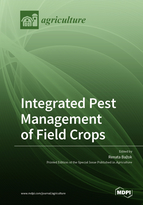Integrated Pest Management of Field Crops
A special issue of Agriculture (ISSN 2077-0472). This special issue belongs to the section "Crop Protection, Diseases, Pests and Weeds".
Deadline for manuscript submissions: closed (15 March 2021) | Viewed by 42474
Special Issue Editor
Interests: applied entomology; pesticide reduction; biological control; natural enemies; integrated pest management
Special Issues, Collections and Topics in MDPI journals
Special Issue Information
Respected Colleagues,
In this Special Issue, we focus on recent advances in and methods for integrated pest management (IPM) in field crops. As a cornerstone of sustainable agriculture, IPM seeks to improve farmer practices in order to create higher profits while improving the environment’s quality. The implementation of IPM principles in agricultural production requires new and updated knowledge generated by science and accepted by farmers. We welcome papers dealing with the development of long-term strategies for the minimization of pest and disease occurrence, preferably by enhancing natural control mechanisms to grow a “healthy crop”. We are interested in all varieties of field crops. Specifically, we are interested in papers dealing with the use of resistant cultivars and varieties, cultural practices that minimize pressure from and maximize biological control over pests and diseases, the development of indicators for quantitative assessment of the balance between pests and beneficial organisms, the development and application of novel techniques for pest and disease forecasting, the use of non-chemical pest and disease management practices, and the development and testing of alternatives to chemical pesticides, biological pest control agents that include microbial and botanical pesticides, and semiochemicals, all of which can be valuable components of IPM.
If you are unsure as to whether your manuscript falls within the scope of this Special Issue, please feel free to send us an abstract.
Prof. Renata Bažok
Guest Editor
Manuscript Submission Information
Manuscripts should be submitted online at www.mdpi.com by registering and logging in to this website. Once you are registered, click here to go to the submission form. Manuscripts can be submitted until the deadline. All submissions that pass pre-check are peer-reviewed. Accepted papers will be published continuously in the journal (as soon as accepted) and will be listed together on the special issue website. Research articles, review articles as well as short communications are invited. For planned papers, a title and short abstract (about 100 words) can be sent to the Editorial Office for announcement on this website.
Submitted manuscripts should not have been published previously, nor be under consideration for publication elsewhere (except conference proceedings papers). All manuscripts are thoroughly refereed through a single-blind peer-review process. A guide for authors and other relevant information for submission of manuscripts is available on the Instructions for Authors page. Agriculture is an international peer-reviewed open access monthly journal published by MDPI.
Please visit the Instructions for Authors page before submitting a manuscript. The Article Processing Charge (APC) for publication in this open access journal is 2600 CHF (Swiss Francs). Submitted papers should be well formatted and use good English. Authors may use MDPI's English editing service prior to publication or during author revisions.
Keywords
- integrated pest management
- field crops






